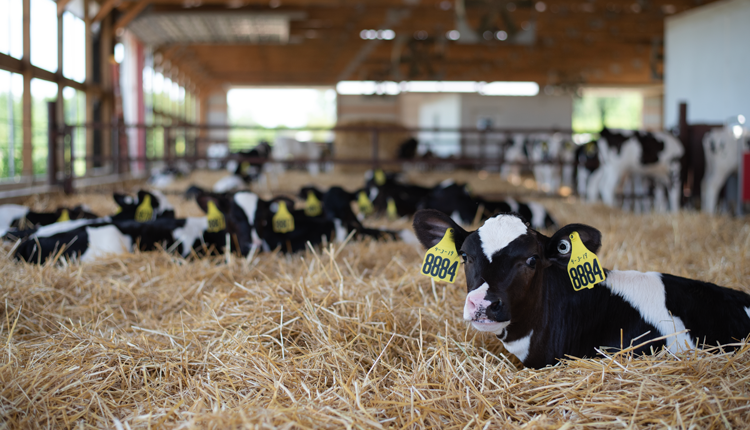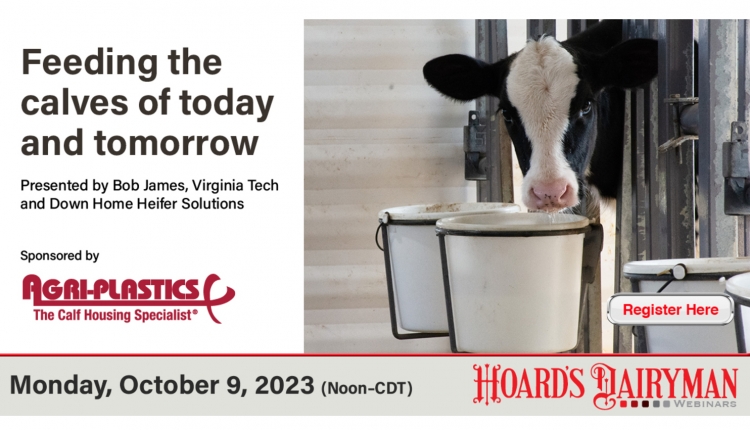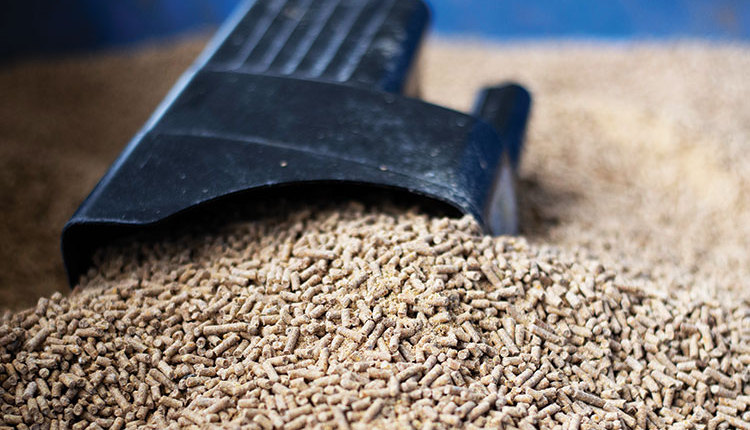The author is the principal in Adhil, LLC, a St. Louis-based consulting firm.
In natural settings, we know weaning can be stressful for both cow and calf. We note the bellowing and cow/calf separation distress. However, other elements of the weaning process actually were minimized in that situation. But, in many current dairy systems, weaning is not handled well, and major stress occurs.
Perhaps the best evidence of this is contained in the most recent USDA National Animal Health Monitoring System (NAHMS) survey. For weaned calves, respiratory problems accounted for the most deaths. They had grown to nearly one-half of the causes for death as compared to about one-third in the previous 1991 survey.
Respiratory problems . . .
Before weaning, scours was the major cause of death and accounted for nearly one-half of mortalities. But it is the "living dead" with respiratory problems that are the major concern. These calves often are affected for life. Epidemiological data from a New York state study in 1995 found that these "respiratory-affected" calves had higher mortality before calving, were less likely to enter the milking herd, took longer before first calving, and had more calving problems.
Why would calves after weaning have such a high incidence of respiratory problems? It is not likely housing in most cases. Rather, making too many changes at once results in stress and the outbreak of respiratory problems.
For example, at 2 months, calves may be moved from a hutch to a group, undergo various treatments or vaccinations, be abruptly or briefly weaned, and then have a major feed change. Each of these changes is significant. Let's look just at some of the feeding aspects.
Increasingly, we have recognized that cows need a transition period from three weeks before to three weeks after calving. Intake changes, ration changes, and rumen adaptation all are major factors in this situation.
Consider that the young calf is just developing its rumen function. As long as calf starter intake remains below 1 pound per day, there will be little significant rumen development. If forage is available during this period, rumen development will be further limited.
If whole milk or milk replacer with more than 15 percent fat is being fed, this will retard starter intake. For each pound of dry milk replacer fed near weaning, calves will eat 2 to 3 pounds less starter. This is a substitution effect, with whole milk and higher fat milk replacers retarding starter intake most.
So, if a week of 1 pound daily starter intake is needed prior to the next week reducing milk or milk replacer by 50 percent, then it may be difficult to wean calves by 6 weeks of age. But, if you wait until 8 weeks of age, then do not move calves at the same time from a hutch to a group and change their feed because now you have created several major changes at once.
Calves experience less stress and do better if they can remain in a hutch two weeks after full weaning. Also, consider keeping calves on the same starter another two weeks after they are moved into small groups and begin to get forage.
Why the need for two weeks both prior to and after weaning? Earlier Cornell and New Hampshire research showed significant rumen papillae and rumen fermentation changes during this overall time period. Again, we know these types of changes occur in cows during the transition period. Calves' rumens still are in the developmental function stage during the two weeks prior to and after weaning. And, contrary to what many still believe, feeding forage before weaning is detrimental to rumen development. The resulting rumen fermentation pattern produces acetic, propionic, and butyric volatile fatty acids in that order. Acid production in just the opposite order is most conducive to rumen papillae development. This pattern is fostered by calf starter fermentation as long as you avoid acidosis.
Water is key . . .
There are several issues that affect calf starter intake. The most critical relate to water. Limiting water availability limits starter intake. About 4 pounds of water are consumed with each pound of starter intake. It is evident then that limiting water intake will limit starter intake.
On the other hand, calves do not like wet, moldy, or stale starter. A common situation is that there is no divider between water and starter buckets. Thus, the calf easily can move its head from one bucket into or over the other bucket. The result is that they dribble water into starter and starter into water. This reduces the intake of both!
With some foresight or modification, a partial divider or further separation of the two buckets can remedy this situation. And remember that rain, snow, or ice without covered buckets will limit starter intake as will moldy or stale starter.
If calves are not given two weeks after weaning to develop their starter intake and develop rumen function more fully, you can expect a slump in growth and health. That is why it is critical that calves not be moved abruptly then. And, when they are moved into a group, keep the size smaller . . . 8 to 12 per group or less, depending on the facility.
Keeping calves on the same starter while introducing forage will minimize disruptions on intake and rumen function. Calves should stay in this transition group for two to four weeks, not unlike cows in a transition group.
By now you may be thinking how can I do all of these things, and won't it be costly! The first thing is to be aware of these factors, and evaluate them in your own operation. Do those things first that are most limiting and least costly.
Also, look at the costs incurred with how you do things now that you may not have recognized. What medication, treatment, and labor costs do you have? How are your calves doing two weeks before and after weaning? What is your weaning program? What performance or respiratory costs may you have for calves before and after weaning? What are the longer-term effects? Do you always have to cull some "poor doers"?
In natural settings, we know weaning can be stressful for both cow and calf. We note the bellowing and cow/calf separation distress. However, other elements of the weaning process actually were minimized in that situation. But, in many current dairy systems, weaning is not handled well, and major stress occurs.
Perhaps the best evidence of this is contained in the most recent USDA National Animal Health Monitoring System (NAHMS) survey. For weaned calves, respiratory problems accounted for the most deaths. They had grown to nearly one-half of the causes for death as compared to about one-third in the previous 1991 survey.
Respiratory problems . . .
Before weaning, scours was the major cause of death and accounted for nearly one-half of mortalities. But it is the "living dead" with respiratory problems that are the major concern. These calves often are affected for life. Epidemiological data from a New York state study in 1995 found that these "respiratory-affected" calves had higher mortality before calving, were less likely to enter the milking herd, took longer before first calving, and had more calving problems.
Why would calves after weaning have such a high incidence of respiratory problems? It is not likely housing in most cases. Rather, making too many changes at once results in stress and the outbreak of respiratory problems.
For example, at 2 months, calves may be moved from a hutch to a group, undergo various treatments or vaccinations, be abruptly or briefly weaned, and then have a major feed change. Each of these changes is significant. Let's look just at some of the feeding aspects.
Increasingly, we have recognized that cows need a transition period from three weeks before to three weeks after calving. Intake changes, ration changes, and rumen adaptation all are major factors in this situation.
Consider that the young calf is just developing its rumen function. As long as calf starter intake remains below 1 pound per day, there will be little significant rumen development. If forage is available during this period, rumen development will be further limited.
If whole milk or milk replacer with more than 15 percent fat is being fed, this will retard starter intake. For each pound of dry milk replacer fed near weaning, calves will eat 2 to 3 pounds less starter. This is a substitution effect, with whole milk and higher fat milk replacers retarding starter intake most.
So, if a week of 1 pound daily starter intake is needed prior to the next week reducing milk or milk replacer by 50 percent, then it may be difficult to wean calves by 6 weeks of age. But, if you wait until 8 weeks of age, then do not move calves at the same time from a hutch to a group and change their feed because now you have created several major changes at once.
Calves experience less stress and do better if they can remain in a hutch two weeks after full weaning. Also, consider keeping calves on the same starter another two weeks after they are moved into small groups and begin to get forage.
Why the need for two weeks both prior to and after weaning? Earlier Cornell and New Hampshire research showed significant rumen papillae and rumen fermentation changes during this overall time period. Again, we know these types of changes occur in cows during the transition period. Calves' rumens still are in the developmental function stage during the two weeks prior to and after weaning. And, contrary to what many still believe, feeding forage before weaning is detrimental to rumen development. The resulting rumen fermentation pattern produces acetic, propionic, and butyric volatile fatty acids in that order. Acid production in just the opposite order is most conducive to rumen papillae development. This pattern is fostered by calf starter fermentation as long as you avoid acidosis.
Water is key . . .
There are several issues that affect calf starter intake. The most critical relate to water. Limiting water availability limits starter intake. About 4 pounds of water are consumed with each pound of starter intake. It is evident then that limiting water intake will limit starter intake.
On the other hand, calves do not like wet, moldy, or stale starter. A common situation is that there is no divider between water and starter buckets. Thus, the calf easily can move its head from one bucket into or over the other bucket. The result is that they dribble water into starter and starter into water. This reduces the intake of both!
With some foresight or modification, a partial divider or further separation of the two buckets can remedy this situation. And remember that rain, snow, or ice without covered buckets will limit starter intake as will moldy or stale starter.
If calves are not given two weeks after weaning to develop their starter intake and develop rumen function more fully, you can expect a slump in growth and health. That is why it is critical that calves not be moved abruptly then. And, when they are moved into a group, keep the size smaller . . . 8 to 12 per group or less, depending on the facility.
Keeping calves on the same starter while introducing forage will minimize disruptions on intake and rumen function. Calves should stay in this transition group for two to four weeks, not unlike cows in a transition group.
By now you may be thinking how can I do all of these things, and won't it be costly! The first thing is to be aware of these factors, and evaluate them in your own operation. Do those things first that are most limiting and least costly.
Also, look at the costs incurred with how you do things now that you may not have recognized. What medication, treatment, and labor costs do you have? How are your calves doing two weeks before and after weaning? What is your weaning program? What performance or respiratory costs may you have for calves before and after weaning? What are the longer-term effects? Do you always have to cull some "poor doers"?









